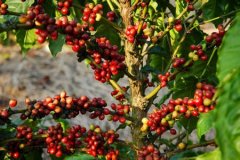The basic knowledge of coffee beans the harvest time and treatment of coffee beans
Harvest and treatment

Harvest occurs in different months of the year (depending on the geographical location of the producing country), depending on the maturity of the fruit. The harvest time depends on the geographical location, climate and altitude, and varies according to the situation of each producing country.
Ripe fruit can be picked by hand, or raked with a small rake, or hit to the ground with a pole: the first two methods can be carried out by low-cost labor, who will operate more selectively; the method of hitting with a pole is faster but not fine enough. and requires further cleaning of the fruit. If the terrain permits, the harvest can be operated by a special automatic machine.
As coffee is a very delicate product, beans must be processed within a few days after harvest. This is to prevent the pulp and covered film from fermenting. There are two ways to process seeds:
"dry" processing, known as "natural" coffee; this method is mainly used in Brazil and West Africa. The fruit is laid on the ground and dried by the sun and constantly turned so that the fruit is evenly exposed to the sun for a period of 15 to 20 days.
"wet" treatment, which is more demanding and more difficult. Using this processing method, you can get coffee that is called "washed" or "soft". This approach has been adopted in Central America, Mexico, Colombia, Kenya and Tanzania. The processing steps are: cleaning, soaking, removing pulp, fermentation, drying and peeling, and finally removing residual impurities and polishing the beans.
The beans are then packed in sacks, usually weighing 60 kilograms (about 132 pounds), and then stored in special sheltered houses. They will begin their own journey-from sacks to bags-to consumer countries.
Important Notice :
前街咖啡 FrontStreet Coffee has moved to new addredd:
FrontStreet Coffee Address: 315,Donghua East Road,GuangZhou
Tel:020 38364473
- Prev

Coffee basics two coffee varieties of coffee beans
Linnaeus (Swedish naturalist) classifies coffee plants into the Rubiaceae family, such as gardenia. The great naturalist named it Coffea. Although wild plants can grow as high as 10-12 meters, the plantations are about 3 to 5 meters high, with the exception of Colombia, where tree species rarely exceed 2 meters. This makes farming and picking easier and more economical to cultivate. Leaves
- Next

The basic knowledge of espresso the common sense of ESPRESSO
Literally, espresso means that it is made on the spot after a customer orders, but when it is used in coffee, it changes from an adjective to a noun. It is a chemical and physical product. Professionally made espresso is made of dissolved sugar, caffeine and protein, oily and colloidal emulsions, suspended coffee particles and tiny bubbles. Vision (cheese-like foam or crema stimulates taste buds)
Related
- Beginners will see the "Coffee pull flower" guide!
- What is the difference between ice blog purified milk and ordinary milk coffee?
- Why is the Philippines the largest producer of crops in Liberia?
- For coffee extraction, should the fine powder be retained?
- How does extracted espresso fill pressed powder? How much strength does it take to press the powder?
- How to make jasmine cold extract coffee? Is the jasmine + latte good?
- Will this little toy really make the coffee taste better? How does Lily Drip affect coffee extraction?
- Will the action of slapping the filter cup also affect coffee extraction?
- What's the difference between powder-to-water ratio and powder-to-liquid ratio?
- What is the Ethiopian local species? What does it have to do with Heirloom native species?

